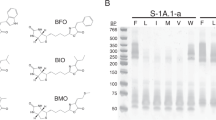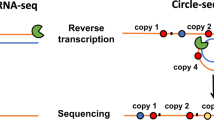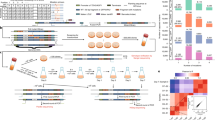Abstract
The error threshold for replication, the critical copying fidelity below which the fittest genotype deterministically disappears, limits the length of the genome that can be maintained by selection. Primordial replication must have been error-prone, and so early replicators are thought to have been necessarily short1. The error threshold also depends on the fitness landscape. In an RNA world2, many neutral and compensatory mutations can raise the threshold, below which the functional phenotype3, rather than a particular sequence, is still present4,5. Here we show, on the basis of comparative analysis of two extensively mutagenized ribozymes, that with a copying fidelity of 0.999 per digit per replication the phenotypic error threshold rises well above 7,000 nucleotides, which permits the selective maintenance of a functionally rich riboorganism6 with a genome of more than 100 different genes, the size of a tRNA. This requires an order of magnitude of improvement in the accuracy of in vitro–generated polymerase ribozymes7,8. Incidentally, this genome size coincides with that estimated for a minimal cell achieved by top-down analysis9, omitting the genes dealing with translation.
This is a preview of subscription content, access via your institution
Access options
Subscribe to this journal
Receive 12 print issues and online access
$209.00 per year
only $17.42 per issue
Buy this article
- Purchase on Springer Link
- Instant access to full article PDF
Prices may be subject to local taxes which are calculated during checkout




Similar content being viewed by others
References
Eigen, M. Self organization of matter and the evolution of biological macromolecules. Naturwissenschaften 10, 465–523 (1971).
Gilbert, W. The RNA world. Nature 319, 618 (1986).
Huynen, M.A., Stadler, P.F. & Fontana, W. Smoothness within ruggedness: the role of neutrality in adaptation. Proc. Natl. Acad. Sci. USA 93, 397–401 (1996).
Reidys, C., Forst, C.V. & Schuster, P. Replication and mutation on neutral networks. Bull. Math. Biol. 63, 57–94 (2001).
Takeuchi, N., Poorthuis, P.H. & Hogeweg, P. Phenotypic error threshold; additivity and epistasis in RNA evolution. BMC Evol. Biol. 5, 9 (2005).
Jeffares, D.C., Poole, A.M. & Penny, D. Relics from the RNA world. J. Mol. Evol. 46, 18–36 (1998).
Johnston, W.K., Unrau, P.J., Lawrence, M.S., Glasen, M.E. & Bartel, D.P. RNA-catalyzed RNA polymerization: accurate and general RNA-templated primer extension. Science 292, 1319–1325 (2001).
Müller, U.F. & Bartel, D.P. Substrate 2′-hydroxyl groups required for ribozyme-catalyzed polymerization. Chem. Biol. 10, 799–806 (2003).
Gil, R., Silva, F.J., Peretó, J. & Moya, A. Determination of the core of a minimal bacterial gene set. Microbiol. Mol. Biol. Rev. 68, 518–537 (2004).
Maynard Smith, J. Hypercycles and the origin of life. Nature 20, 445–446 (1979).
Maynard Smith, J. Models of evolution. Proc. R. Soc. Lond. B 219, 315–325 (1983).
Maynard Smith, J. & Szathmáry, E. The Major Transitions in Evolution (Oxford Univ. Press, Oxford, 1995).
Benner, B., Ellington, A.D., Ge, L., Gasfeld, A. & Leanz, G.F. Natural selection, protein enzgineering, and the last riboorganism: rational model building in biochemistry. Cold Spring Harb. Symp. Quant. Biol. 52, 56–63 (1987).
Fedor, M. Structure and function of the hairpin ribozyme. J. Mol. Biol. 297, 269–291 (2000).
Lafontaine, D.A., Norman, D.G. & Lilley, D.M.J. The structure and active site of the Varkund satellite ribozyme. Biochem. Soc. Trans. 30, 1170–1175 (2002).
Lehman, N. & Joyce, G.F. Evolution in vitro: analysis of a lineage of ribozymes. Curr. Biol. 3, 723–734 (1993).
Takeda, Y., Sarai, A. & Rivera, V.M. Analysis of the sequence-specific interactions between Cro repressor and operator DNA by systematic base substitution experiments. Proc. Natl. Acad. Sci. USA 86, 439–443 (1989).
Sandberg, W.S. & Terwilliger, T.C. Engineering multiple properties of a protein by combinatorial mutagenesis. Proc. Natl. Acad. Sci. USA 90, 8367–8371 (1993).
Skinner, M.M. & Terwilliger, T.C. Potential use of additivity of mutational effects in simplifying protein engineering. Proc. Natl. Acad. Sci. USA 93, 10753–10757 (1996).
Eigen, M., McCaskill, J.S. & Schuster, P. The molecular quasispecies. Adv. Chem. Phys. 75, 149–263 (1989).
Santos, M., Zintzaras, E. & Szathmáry, E. Recombination in primeval genomes: a step forward but still a long leap from maintaining a sizeable genome. J. Mol. Evol. 59, 507–519 (2004).
Domingo, E. & Holland, J.J. in The Evolutionary Biology of Viruses (ed. Morse, S.S.) 161–183 (Raven, New York, 1994).
Hofacker, I.L. et al. Fast folding and comparison of RNA secondary structures. Monatsh. Chem. 125, 167–188 (1994).
Hofacker, I.L. Vienna RNA secondary structure server. Nucleic Acids Res. 31, 3429–3431 (2003).
Beattie, T.L., Olive, J.E. & Collins, R.A. A secondary-structure model for the self-cleaving region of the Neurospora VS RNA. Proc. Natl. Acad. Sci. USA 92, 4686–4690 (1995).
Butcher, S.E. & Burke, J.M. Structure-mapping of the hairpin ribozyme. Magnesium-dependent folding and evidence for tertiary interactions within the ribozyme-substrate complex. J. Mol. Biol. 244, 52–63 (1994).
Butcher, S.E. & Burke, J.M. A photo-cross-linkable tertiary structure motif found in functionally distinct RNA molecules is essential for catalytic function of the hairpin ribozyme. Biochemistry 33, 992–999 (1994).
Acknowledgements
We thank I. Hofacker for his help with the Vienna RNA package, P. Mezey for allowing us to use the computer facilities at MUN (Canada) and F. Kondrashov for comments on an earlier version of the manuscript. Computer facilities were provided by Microdigit. This work was supported by grant and postdoctoral fellowship from the Hungarian National Research Fund (OTKA) to Á.K. M.S. is partially supported by Fundación Ramón Areces (Spain). This work was also supported by the COST D27 action (Prebiotic chemistry and early evolution).
Author information
Authors and Affiliations
Corresponding author
Ethics declarations
Competing interests
The authors declare no competing financial interests.
Supplementary information
Supplementary Table 1
Mutations of the Neurospora VS ribozyme. (PDF 35 kb)
Supplementary Table 2
Mutations of the Hairpin ribozyme. (PDF 32 kb)
Supplementary Note
Construction of the empirically-supported fitness landscape for the Neurospora VS and the hairpin ribozyme. (PDF 58 kb)
Rights and permissions
About this article
Cite this article
Kun, Á., Santos, M. & Szathmáry, E. Real ribozymes suggest a relaxed error threshold. Nat Genet 37, 1008–1011 (2005). https://doi.org/10.1038/ng1621
Received:
Accepted:
Published:
Issue Date:
DOI: https://doi.org/10.1038/ng1621
This article is cited by
-
Ribozyme Mutagenic Evolution: Mechanisms of Survival
Origins of Life and Evolution of Biospheres (2021)
-
Negative Epistasis in Experimental RNA Fitness Landscapes
Journal of Molecular Evolution (2017)
-
Cooperation and selfishness both occur during molecular evolution
Biology Direct (2015)
-
Quasispecies in population of compositional assemblies
BMC Evolutionary Biology (2014)
-
The Case for an Early Biological Origin of DNA
Journal of Molecular Evolution (2014)



